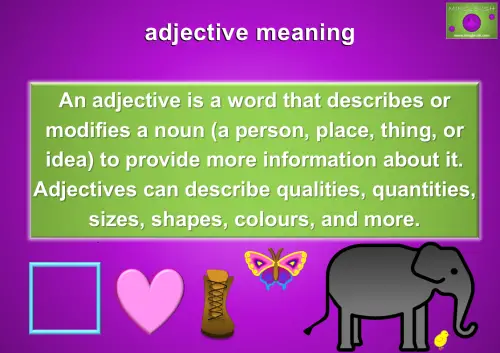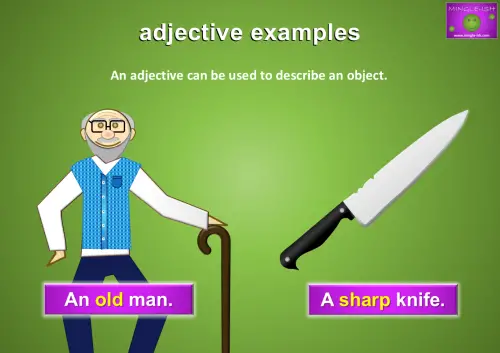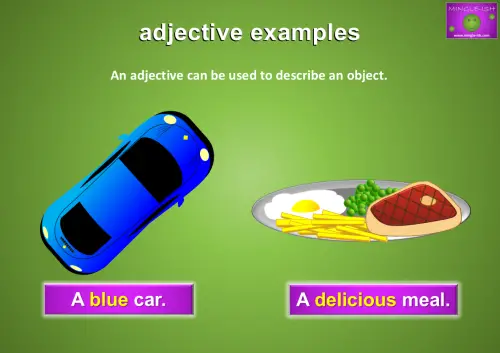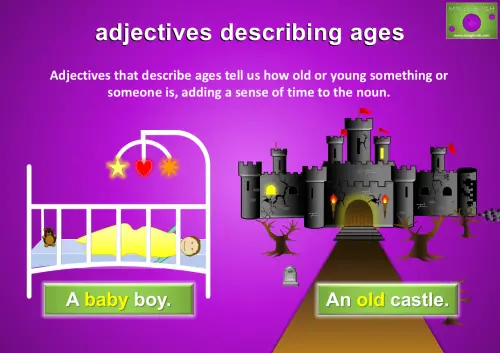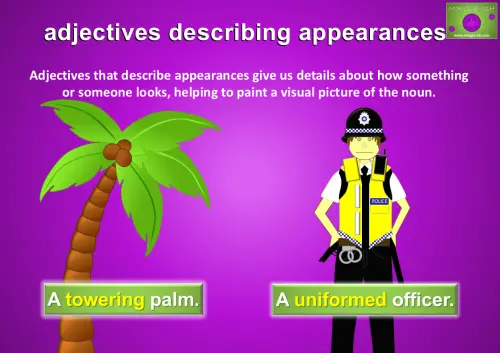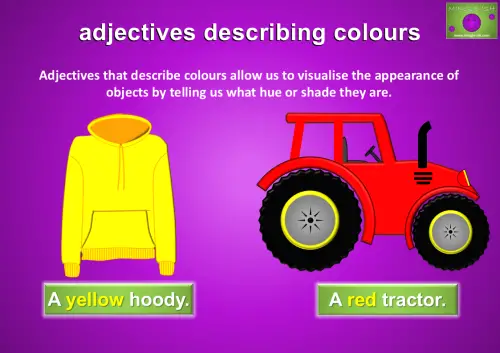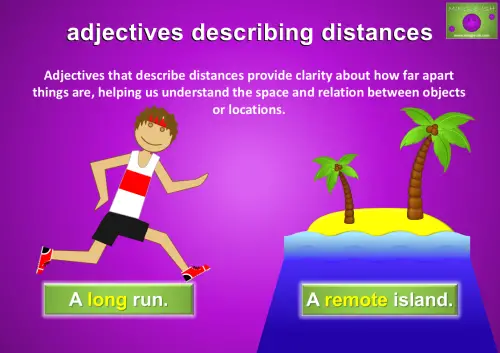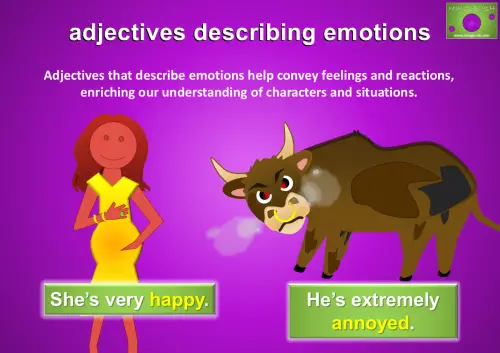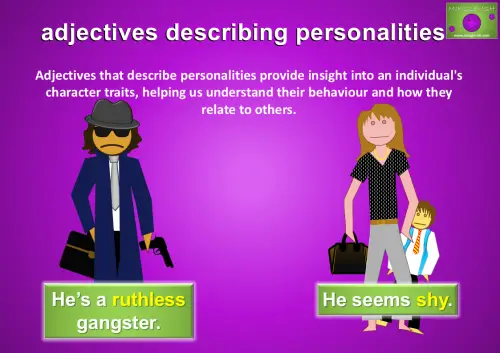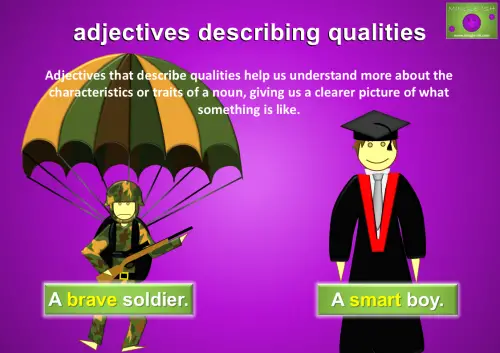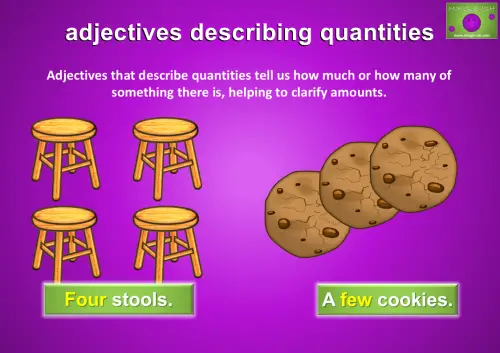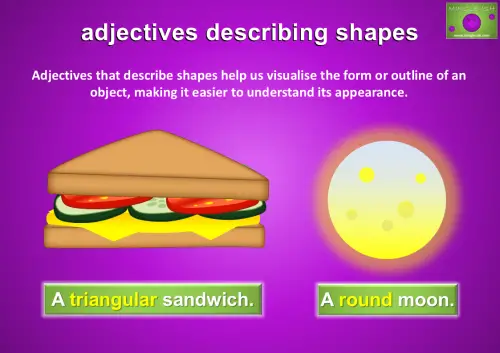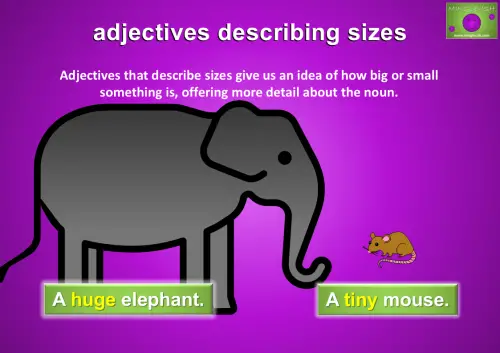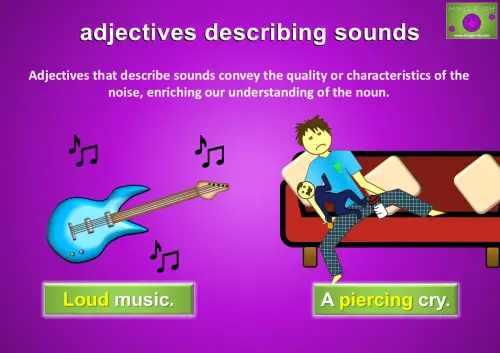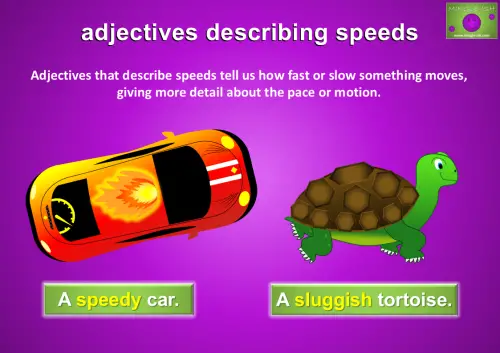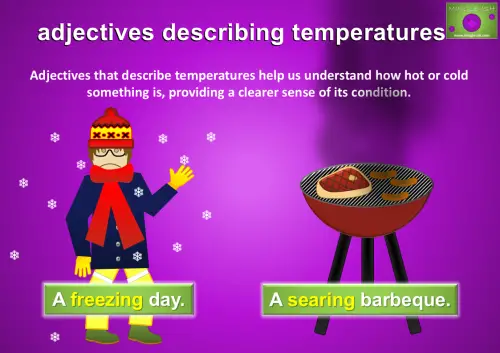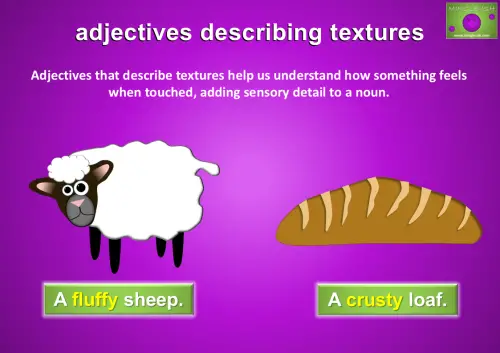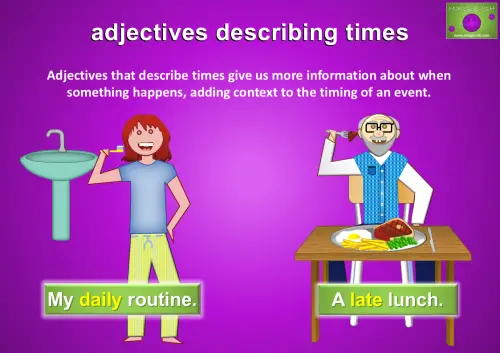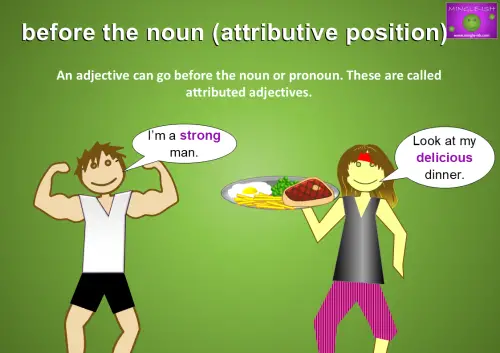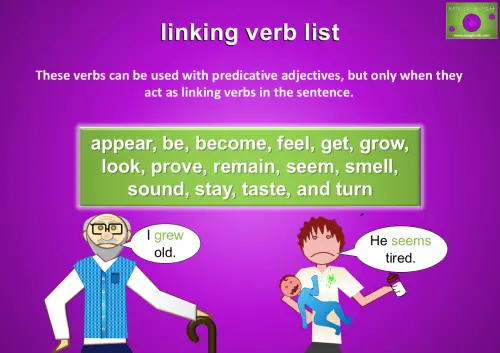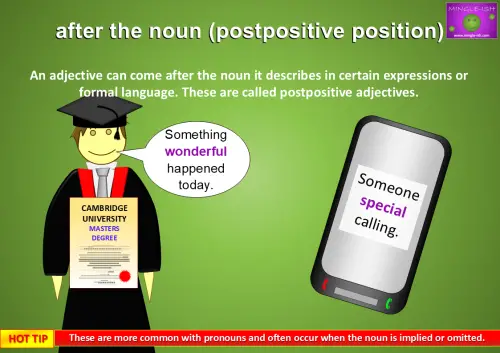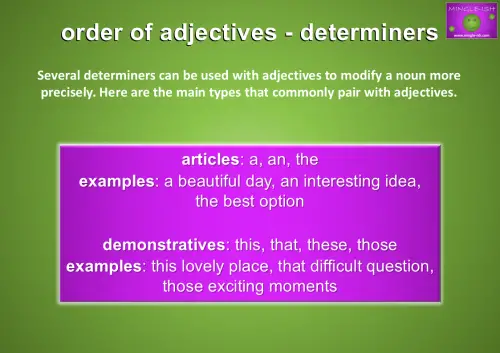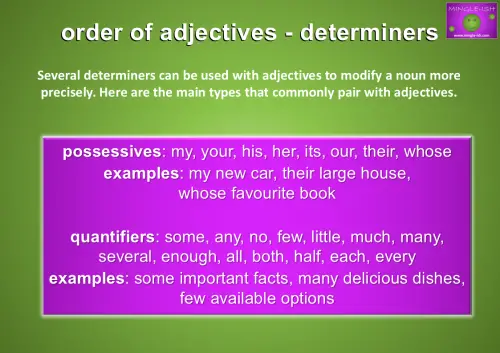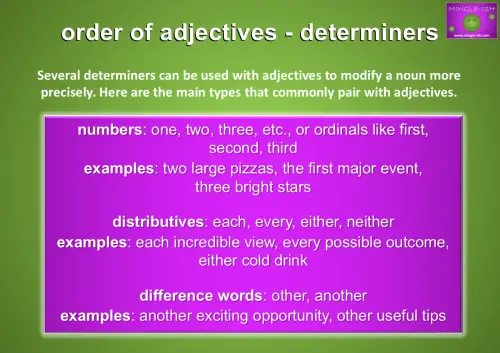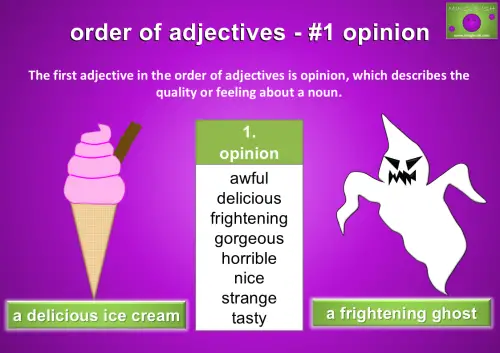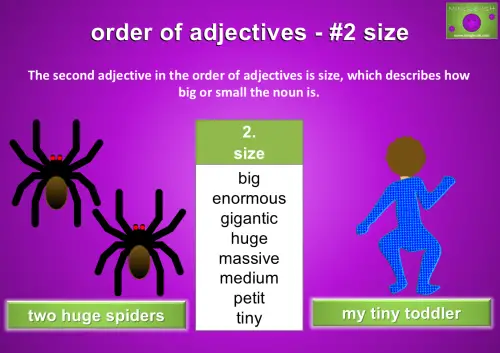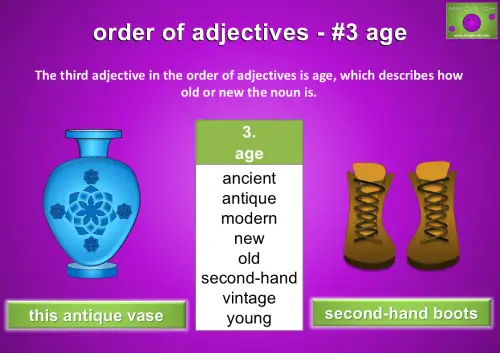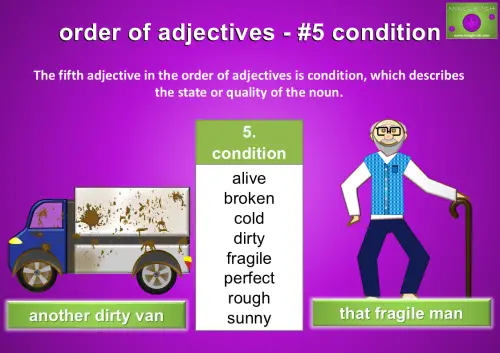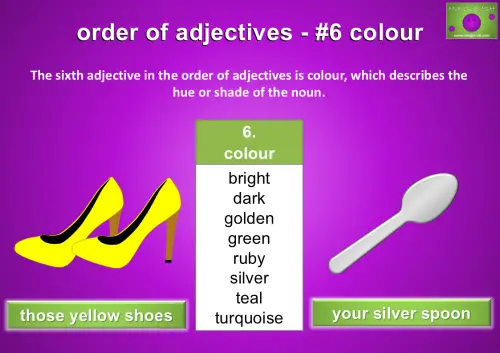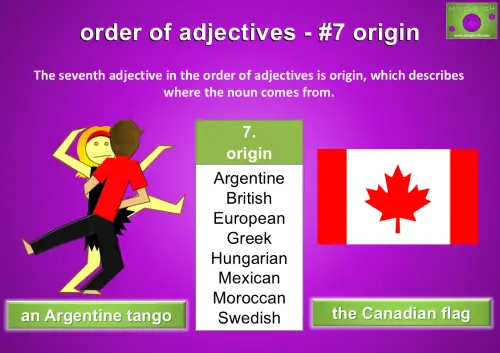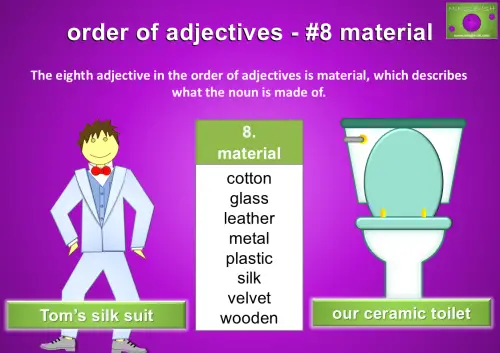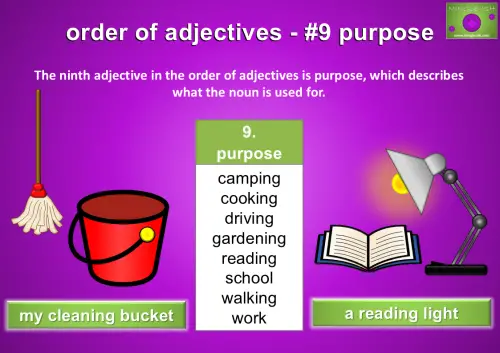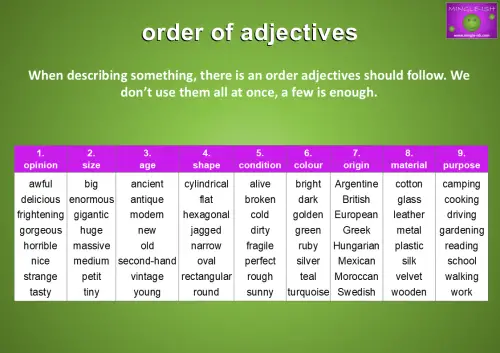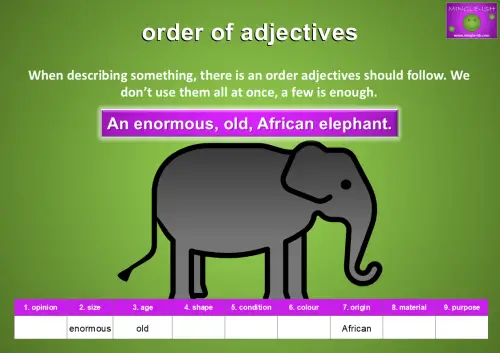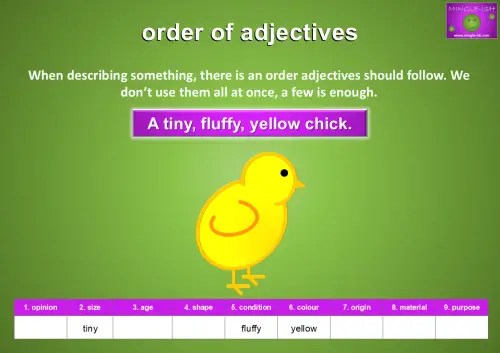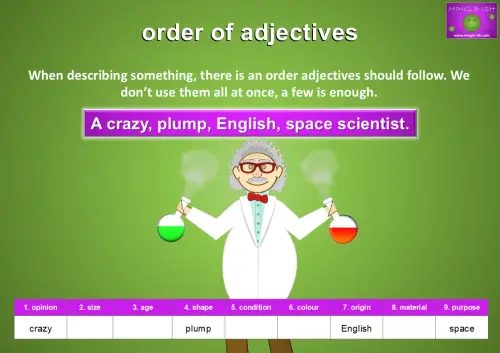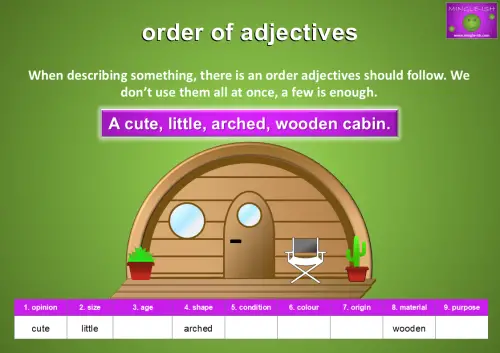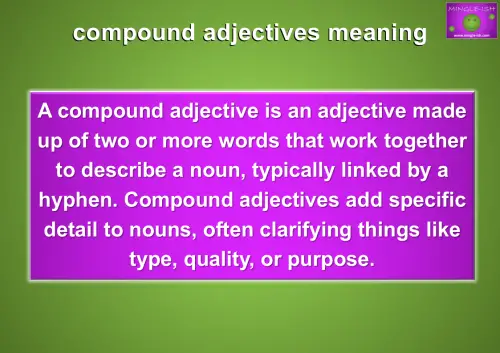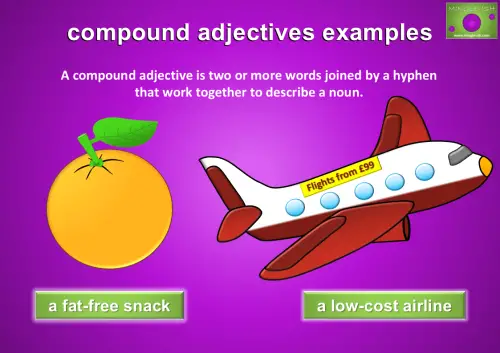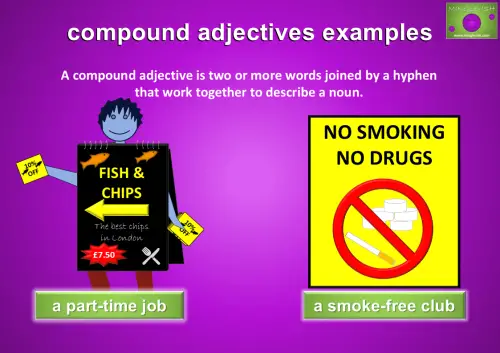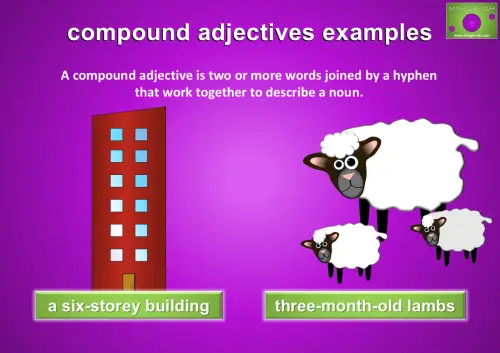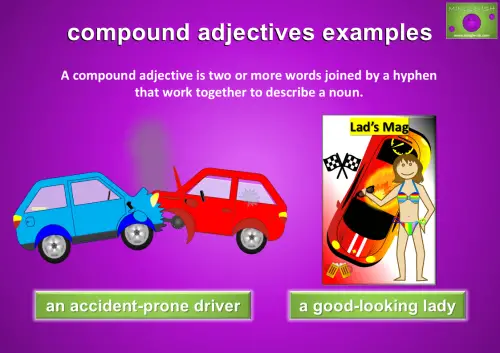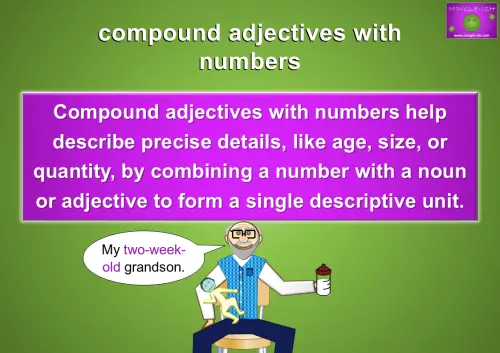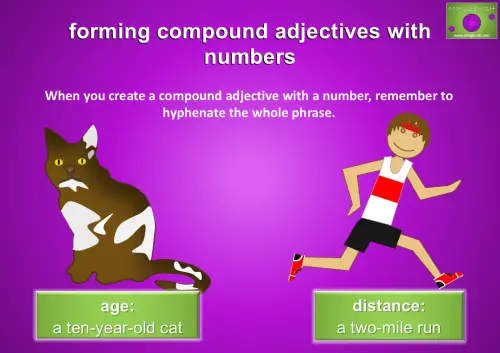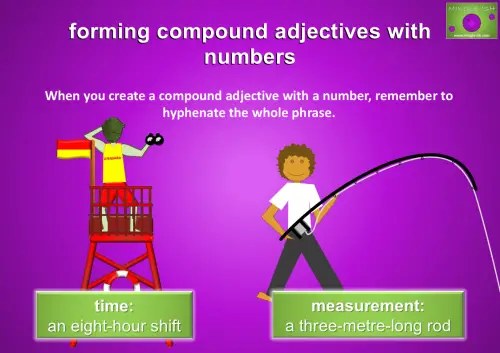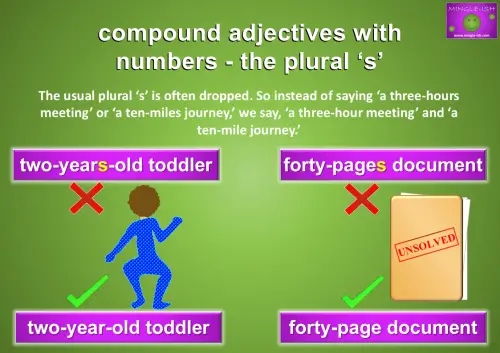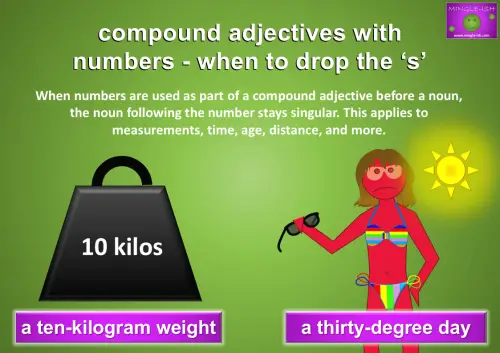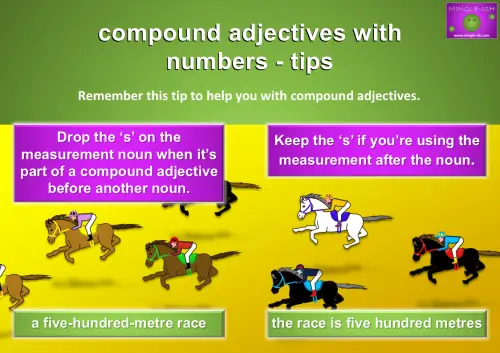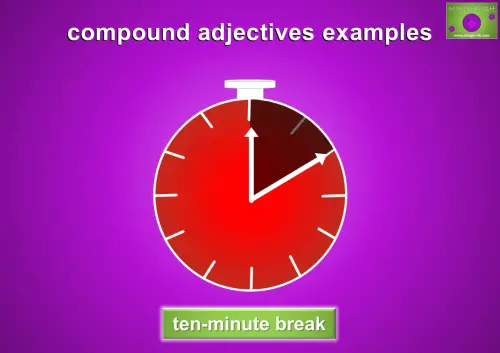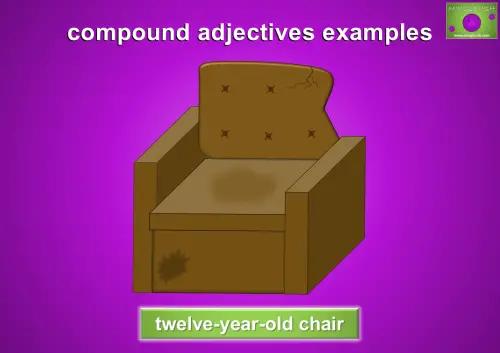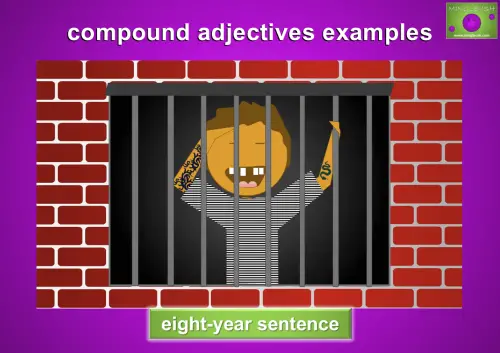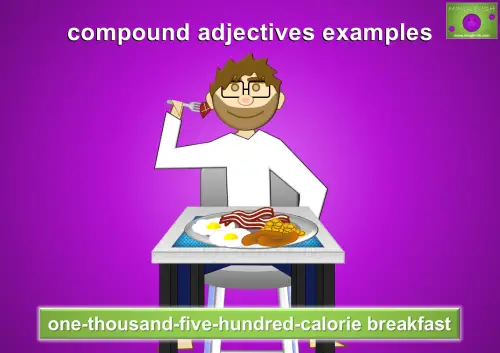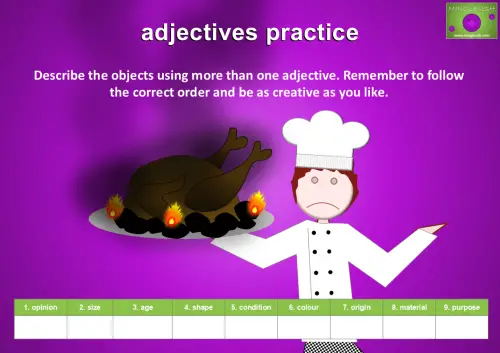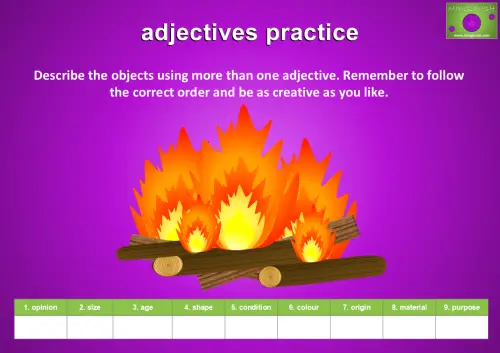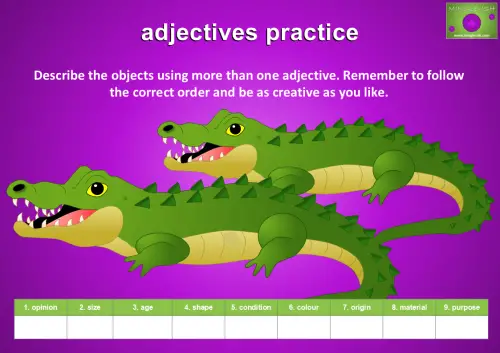What is an adjective?
An adjective is a word that describes or modifies a noun (a person, place, thing, or idea) to provide more information about it. Adjectives can describe qualities, quantities, sizes, shapes, colours, and more.
They can be used to describe an object, for example:
- An old man.
- A sharp knife.
- A blue car.
- A delicious meal.
Examples of Common Adjectives and How to Use Them
Ready to dive into the world of adjectives? Here are some common adjectives you can use to describe people, places, and things. Try creating your own sentences with these adjectives to improve your grammar and writing skills.
Ages
Adjectives that describe ages tell us how old or young something or someone is, adding a sense of time to the noun.
Examples:
- The young child ran across the field.
- They live in an old house by the river.
- She adopted a new puppy yesterday.
- He found an ancient artefact at the museum.
- My elderly neighbour enjoys gardening.
Appearances
Adjectives that describe appearances give us details about how something or someone looks, helping to paint a visual picture of the noun.
Examples:
- The tall woman stood by the door.
- They bought a sleek car last week.
- She wore a colourful dress to the party.
- He found a shiny coin on the street.
- My scruffy dog loves to play in the mud.
Colours
Adjectives that describe colours allow us to visualise the appearance of objects by telling us what hue or shade they are.
Examples:
- She wore a red dress to the party.
- The sky was a clear blue today.
- He bought a green bicycle.
- The yellow flowers brightened up the garden.
- They painted the walls white for a fresh look.
Distances
Adjectives that describe distances provide clarity about how far apart things are, helping us understand the space and relation between objects or locations.
Examples:
- We took a short walk to the corner shop.
- Their new house is quite far from the city centre.
- She prefers living in a nearby town rather than in the city.
- The long journey through the countryside was worth it for the views.
- He drove a considerable distance to attend the meeting.
Emotions
Adjectives that describe emotions help convey feelings and reactions, enriching our understanding of characters and situations.
Examples:
- He gave her a comforting smile during the tough times.
- The joyful celebration brought everyone together.
- She felt an overwhelming sense of sadness after the news.
- The exciting game kept everyone on the edge of their seats.
- His angry outburst surprised everyone in the room.
Personalities
Adjectives that describe personalities provide insight into an individual’s character traits, helping us understand their behaviour and how they relate to others.
Examples:
- She is a friendly person who makes everyone feel welcome.
- His adventurous spirit always leads him to try new things.
- They appreciate her thoughtful nature in planning events.
- He has a quirky sense of humour that keeps everyone laughing.
- Her determined attitude helps her overcome challenges.
Qualities
Adjectives that describe qualities help us understand more about the characteristics or traits of a noun, giving us a clearer picture of what something is like.
Examples:
- A brave firefighter saved the day.
- She is a kind person.
- The intelligent student aced the exam.
- It was a peaceful afternoon.
- His generous offer surprised everyone.
Quantities
Adjectives that describe quantities tell us how much or how many of something there is, helping to clarify amounts.
Examples:
- She ate several cookies.
- We have enough time to finish.
- There were many people at the event.
- He found a few coins on the ground.
- They made countless memories on their trip.
Shapes
Adjectives that describe shapes help us visualise the form or outline of an object, making it easier to understand its appearance.
Examples:
- She wore a round necklace.
- The table had a rectangular top.
- We played with a square toy.
- The artist painted triangular mountains.
- They arranged the flowers in a circular pattern.
Sizes
Adjectives that describe sizes give us an idea of how big or small something is, offering more detail about the noun.
Examples:
- The tiny kitten fit in the palm of my hand.
- He drove a massive truck down the road.
- They live in a small house by the sea.
- She ordered a large pizza for dinner.
- The gigantic tree towered over the others.
Sounds
Adjectives that describe sounds convey the quality or characteristics of the noise, enriching our understanding of the noun.
Examples:
- The soft music played in the background.
- They heard a loud crash outside the window.
- She listened to the gentle whispers of the wind.
- He discovered a haunting melody in the old record.
- My friend loves the crisp sound of autumn leaves crunching underfoot.
Speeds
Adjectives that describe speeds tell us how fast or slow something moves, giving more detail about the pace or motion.
Examples:
- He drives a fast car on the motorway.
- The slow turtle made its way across the road.
- She completed the task at a quick pace.
- The rapid response was appreciated.
- The snail’s leisurely crawl was fascinating to watch.
Temperatures
Adjectives that describe temperatures help us understand how hot or cold something is, providing a clearer sense of its condition.
Examples:
- She drank a hot cup of tea in the morning.
- The weather was freezing during the winter.
- They enjoyed a warm day at the beach.
- I prefer my coffee cold in the summer.
- The soup was still lukewarm after being left out.
Textures
Adjectives that describe textures help us understand how something feels when touched, adding sensory detail to a noun.
Examples:
- The blanket was incredibly soft.
- He touched the rough surface of the stone.
- The bread had a crusty exterior.
- She admired the smooth finish of the table.
- The towel felt fluffy after drying in the sun.
Times
Adjectives that describe times give us more information about when something happens, adding context to the timing of an event.
Examples:
- We had an early breakfast before the hike.
- The late train finally arrived at the station.
- She enjoys nightly walks around the neighbourhood.
- The annual festival attracts a big crowd.
- He made a brief visit to the office this morning.
Adjective Placement in Sentences
Adjectives can appear in different places within a sentence, depending on their role in describing a noun or pronoun, and understanding these placements will greatly improve the clarity and fluency of your writing. Here are the two main positions:
- Before the noun
- after the linking verb.
Let’s take a look at them in more detail.
Before the noun (Attributive Position)
This is the most common placement, where the adjective directly precedes the noun it describes. For example:
- She wore a beautiful dress
- They live in a large house.
The adjective beautiful describes the noun dress, and large describes house. In both cases, the adjective comes right before the noun, adding detail to the object.
After a linking verb (Predicative Position)
In this case, the adjective follows a linking verb such as be, seem, feel, or become. Instead of directly modifying the noun, the adjective provides information about the subject of the sentence. For example:
- The dress is beautiful.
- He seems happy.
Here, beautiful and happy are adjectives that describe the subject through the linking verbs is and seems.
Here’s a list of common linking verbs:
- appear – He appears upset.
- be (am, is, are, was, were, been, being) – She is frightened.
- become – We’re becoming jealous.
- feel – He feels happy.
- get – She gets angry.
- grow – He grew old.
- look – She looks upset.
- prove – The theory proved false.
- remain – He remained calm.
- seem – She seems paranoid.
- smell – The roses smell sweet.
- sound – That sounds great.
- stay – He stayed quiet.
- taste – The soup tastes delicious.
- turn – The sky turned grey.
These verbs link the subject of a sentence to additional information about the subject, usually in the form of a predicative adjective or noun.
Before a noun (Postpositive Position)
Order of adjectives in a sentence
When it comes to using multiple adjectives in a sentence, knowing the correct order can make all the difference! In English, adjectives typically follow a specific sequence to create clear and natural-sounding phrases. In this section, we’ll break down the rules of adjective order, so you can enhance your writing and speaking skills effortlessly. From opinions and size to colour and origin, we’ll cover everything you need to know to master the art of adjective placement.
The good news is that It doesn’t really matter that much (only if you want perfect English). The listener will still be able to understand. Let’s dive in!
Several determiners can be used with adjectives to modify a noun more precisely. Here are the main types that commonly pair with adjectives.
- articles: a, an, the
examples: a beautiful day, an interesting idea, the best option - demonstratives: this, that, these, those
examples: this lovely place, that difficult question, those exciting moments - possessives: my, your, his, her, its, our, their, whose
examples: my new car, their large house, whose favourite book - quantifiers: some, any, no, few, little, much, many, several, enough, all, both, half, each, every
examples: some important facts, many delicious dishes, few available options - numbers: one, two, three, etc., or ordinals like first, second, third
examples: two large pizzas, the first major event, three bright stars - distributives: each, every, either, neither
examples: each incredible view, every possible outcome, either cold drink - difference words: other, another
examples: another exciting opportunity, other useful tips
When you’re using more than one adjective to describe a noun, there’s generally a specific order that they follow to make the sentence sound natural and clear in English. Let’s take a look.
Opinion:
Adjectives that express personal feelings or evaluations.
- Examples: lovely, boring, beautiful
Size:
Adjectives that indicate how big or small something is.
- Examples: tiny, big, enormous
Age:
Adjectives that describe how old something is.
- Examples: old, young, new
Shape:
Adjectives that describe the form or outline of something.
- Examples: round, square, triangular
Condition:
Adjectives that indicate the state of something.
- Examples: used, broken, pristine
Colour:
Adjectives that specify the hue of something.
- Examples: red, blue, green
Origin:
Adjectives that indicate where something comes from.
- Examples: Italian, American, French
Material:
Adjectives that describe what something is made of.
- Examples: wooden, plastic, metal
Purpose:
Adjectives that indicate the intended use of something.
- Examples: sleeping bag, racing bike
So, just to recap:
The order of adjectives in English follows a specific sequence to make descriptions sound natural. First, we use determiners like “a” or “my,” followed by opinion adjectives, which give a personal view, like “lovely” or “ugly.” Then comes size (big, small), age (new, old), and shape (round, square). Next is condition (broken, perfect), then colour (red, blue), origin (French, Japanese), material (wooden, metal), and finally purpose (cooking, sleeping). For example, we’d say “a lovely small old round Japanese wooden cooking bowl” to get the order just right!
To finish, here are a few examples demonstrating the correct order of adjectives:
- An enormous, old, African elephant.
- A tiny, fluffy, yellow chick.
- A crazy, plump, English, space scientist.
- A cute, little, arched, wooden cabin.
Types of adjectives
Compound adjectives
A compound adjective is an adjective made up of two or more words that work together to describe a noun, typically linked by a hyphen. Compound adjectives add specific detail to nouns, often clarifying things like type, quality, or purpose.
Let’s see some examples:
- a fat-free snack
- a low-cost airline
- a part-time job
- a smoke-free club
- a six-storey building
- three-month-old lambs
- an accident-prone driver
- a good-looking lady
Compound adjectives with numbers
Compound adjectives with numbers help describe precise details, like age, size, or quantity, by combining a number with a noun or adjective to form a single descriptive unit.
How Compound Adjectives with Numbers Work
When you create a compound adjective with a number, remember to hyphenate the whole phrase. For example:
- age: a ten-year-old cat
- distance: a two-mile walk
- time: a three-hour meeting
- measurement: a three-metre-long rod
This structure applies whether the number is written in words (like “five”) or in numerals (like “5”), although using words is generally better in more formal writing.
Dropping the ‘s’ in Compound Adjectives with Numbers
In compound adjectives with numbers, you might notice something interesting: the usual plural “s” is often dropped. So instead of saying “a three-hours meeting” or “a ten-miles journey,” we say “a three-hour meeting” and “a ten-mile journey.” This might feel odd, but it’s done to keep the phrase concise and focused as a single descriptive unit.
When to Drop the ‘s’
When numbers are used as part of a compound adjective before a noun, the noun following the number stays singular. This applies to measurements, time, age, distance, and more. Here are some examples:
- amount: a two-cup measurement (not ‘two-cups measurement’)
- age: a six-year-old child (not ‘six-years-old child’)
- area: a fifty-square-foot room (not ‘fifty-square-feet room’)
- depth: a ten-metre-deep pool (not ‘ten-metres-deep pool’)
- distance: a five-mile run (not ‘five-miles run’)
- height: a six-foot-tall person (not ‘six-feet-tall person’)
- quantity: a five-item checklist (not ‘five-items checklist’)
- speed: a fifty-mile-per-hour wind”(not ‘fifty-miles-per-hour wind’)
- temperature: a twenty-degree day (not ‘twenty-degrees day’)
- time: a two-hour delay (not ‘two-hours delay’)
- weight: a ten-kilogram box (not ‘ten-kilograms box’)
Remember:
- drop the ‘s’ on the measurement noun when it’s part of a compound adjective before another noun. (e.g. The two-hour meeting.)
- keep the ‘s’ if you’re using the measurement after the noun. (e.g. The meeting lasted two hours).
Dropping the ‘s’ might feel odd at first, but it’s one of those subtle tricks that makes your English sound more natural and polished!
Here are a few more examples of compound adjectives with numbers. Have a look and practice saying them without the ‘s’.
Can you think of any others?
Practice Using Adjectives: Describe These Objects with Creativity
Now it’s your turn to practice your adjective skills! Try describing these objects with more than one adjective, using the correct adjective order. Get creative and challenge yourself to use a variety of descriptive words. Ready to improve your adjective use? Start now!
Do you want to learn more about adjectives?
This page has given you a quick overview of adjectives in English, so you should now feel confident in spotting them in sentences. Since adjectives are essential to everyday English, there’s even more to explore – like unique ways to use them and tips to enhance your writing with adjectives. Ready to deepen your knowledge? Click the links below for more on mastering adjectives!
adjective quizzes
Have a go at these fun quizzes to test your knowledge of adjectives and see how confidently you can describe people, places, and things in English.
